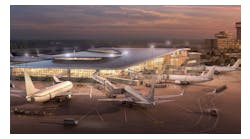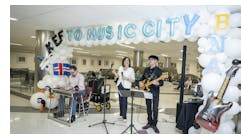Is it Time to Close Hartford’s Brainard Airport? Some See Major Development Opportunity in 100-Year-Old Airfield in the City.
Hartford-Brainard Airport — the century-old airfield in Hartford’s South Meadows — is again in the crosshairs of those who argue the airport has long outlived its usefulness and should be closed for redevelopment.
The Hartford City Council is considering a measure that would urge closing of the airport, a question that has been debated since the 1950s. Meanwhile, discussions about the airport’s future between top elected leaders and airport officials are continuing.
Hartford City Councilman James Sanchez is sponsoring a resolution that seeks the return of the state-owned airport’s 201 acres to the city for redevelopment. The redevelopment would provide a sorely-needed boost to the city’s tax rolls and open up another point of access to Hartford’s riverfront, Sanchez said.
“It’s an awesome economic development opportunity for the city of Hartford, and I’ll tell you our mill rate is fairly high,” Sanchez said. “This is another opportunity to have a development that can be put back on the grand list. It is promising and will help us drop our mill rates, not only for our homeowners but for our small businesses.”
Hartford Mayor Luke Bronin, who first campaign for mayor in 2015 pushing for decommissioning the airport, said discussions with the Connecticut Airport Authority, which oversees Brainard’s operations, “have been productive and honest” about what closing the airport might entail.
“There are higher and better uses for that land than a small general service airport that primarily serves a small number of recreational pilots,” Bronin said. “This airport occupies 200 acres at the intersection of two major highways and along the Connecticut River.”
CAA’s top executive said opposition from Hartford and Wethersfield on tree trimming to meet requirements on visibility for planes taking off and landing could erode Brainard’s viability.
Kevin A. Dillon, the CAA’s executive director, said that could force Brainard to shorten its runway, rather than extend it, as the CAA would like to do, so it can accommodate larger aircraft.
“We do believe the airport can serve as an economic development tool for the city,” Dillon said. “One of the things about Brainard: you don’t see too many cities of any size that have an airport on their doorstep like that.”
Dillon said the CAA, which has long defended the need for Brainard, believes the city should be promoting Brainard as an economic development asset.
“If the city does not see it as a value to them, and there’s going to be continued resistance, if you will, to things like tree removal, yeah, it’s probably time for us to talk about what is the future of Brainard Airport.”
100 year history
Brainard, opened in 1921, has a storied history. Charles Lindbergh launched his 1927 heroes tour at Brainard after his transatlantic flight, eventually visiting each state. Eastern Airlines took its first passengers from the airport. And the first nylon parachutes were tested at Brainard during World War II.
But in the 1950s, a large runway at Brainard was taken for the development that became the South Meadows commercial and industrial district off Brainard Road.
The downsizing of the airport touched off a debate that has ebbed and flowed for decades about the future of Brainard.
A 95-page legislative report issued in 2016 recommended further investment in Brainard, however, rather than redevelopment. Redevelopment, the report said, would be too costly, require large public subsidies and take at least two decades.
The report noted that the state’s payment in lieu of taxes amounted to $478,000. The payment fell far short of property taxes of as much as $1.6 million that would have been paid if the land was in private hands. Steps should be taken, the report said, to bring the payment more in line with the higher figure.
Brainard logs an annual operating loss of up to $500,000, not counting capital contributions from the state that can vary widely year-to-year. But the report also pointed out the airport generated $43 million in statewide economic activity annually and was responsible for 111 private-sector jobs directly at the airport.
Decommissioning an airport is a time-consuming process and would require, among other things, repaying $2 million in federal grants.
There is no current redevelopment plan for the airport. The last was drawn up in 2006 and headed by the Metropolitan District Commission. the regional water and sewer authority. The plan, last resurrected in 2016, covered not only the airport but also the neighboring, 95-acre trash-to-energy plant.
The 2006 vision called for 7 million square feet of commercial and manufacturing space, stores, apartments, a marina, a rebuilt trash-to-energy plant and a river park.
In the years since, the Materials Innovation and Recycling Authority has decided to close rather than upgrade the trash burning plant in 2022. The site would then host a transfer station for trucking trash of the state.
The closing of the trash-to-energy plant potentially enlarges a redevelopment site to 300 acres, a move that would require a new, permanent transfer station to be built elsewhere.
The recent talks about Brainard’s future also come as the Capital Region Development Authority examines long-term plans for the regional market that is also nearby.
Bronin said he is undeterred by the challenges, including the “many years and many millions” it might take for a clean-up of the trash-to-energy plant property.
“It may be years before we realize the full benefit of either of these sites, but part of the job of positioning the city to grow in the future and to create economic opportunity for the next generation is to lay that foundation now,” Bronin said.
Sen. John W. Fonfara, D- Hartford, also a longtime proponent of redeveloping the airport, said a redevelopment could be an asset for the region, not just Hartford.
Fonfara said it is time to think big, and he envisions a transformation similar to the Inner Harbor in Baltimore. Baltimore’s waterfront morphed over decades from a rundown industrial area into a cultural and entertainment mecca.
“Obviously, this area is not as large as the Inner Harbor, but it could be where you have a cove — not the size of Wethersfield Cove — but you could have a cove that comes off the river,” Fonfara said. “You could have a lot of recreation happening in that area. The potential is endless in my opinion.”
Contact Kenneth R. Gosselin at [email protected].
©2021 Hartford Courant. Visit courant.com. Distributed by Tribune Content Agency, LLC.



